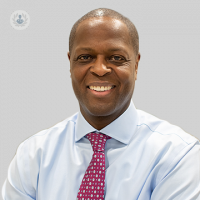Regenerative medicine – an alternative to joint replacement surgery?
Autore:Medicine is a constantly changing field. Throughout its history, new discoveries and inventions have changed the way we look at the human body and how we treat the many diseases and injuries that can afflict it. One of the latest fields to emerge is that of regenerative medicine, which aims to provide non-surgical treatments designed to stimulate the body to heal itself. Dr Ralph Rogers is a leader in using regenerative treatments in sports medicine.

What is regenerative medicine?
Regenerative medicine is a potentially game-changing field, with research into cutting edge, non-surgical therapies designed to optimise healing. These treatments aim to boost the human body’s natural self-healing abilities, often by delivering certain types of cells or cell products to the affected part of the body.
The principles behind regenerative medicine aren’t new – procedures like bone marrow transplants have been performed for decades. Now, a number of procedures are of interest to the medical community, particularly in the fields of orthopaedics and wound-healing. Treatments like platelet-rich plasma (PRP) and Lipogems® have proven successful at treating sports injuries, including in the cases of several famous athletes, such as Tiger Woods and Rafael Nadal. A number of clinical trials are being conducted to study the efficacy and mechanisms of these treatments, and are showing positive results. Dr Rogers has seen the life-changing healing effect of regenerative medicine first hand. Lipogems®, for example, in some patients has not only delayed the need for joint replacement surgery, but has prevented the need for invasive surgery altogether. Would you consider regenerative medicine as an alternative to joint replacement therapy?
Lipogems®
Lipogems® is a relatively new treatment that is particularly effective for osteoarthritis pain. The treatment involves taking adipose (fat) from the patient’s body to create an injectable tissue to cushion and support the area around an injury, helping it to heal.
First, the doctor performs liposuction on the patient to collect a small sample of fat. Then, the Lipogems® device is used to clean and emulsify the fat to create the Lipogems® for injection back into the patient. Lipogems® has been employed in more than 8,000 clinical cases around the world, while clinical studies at major research institutes are ongoing.
Platelet-rich plasma (PRP)
The blood is composed mainly of plasma (fluid) and red blood cells. Less than 1% of the blood is made up of white blood cells, which fight disease, and platelets. During injury, platelets clump together to form clots to stop bleeding. They also contain growth factors, which promote healing.
PRP therapy involves taking a small sample of the patient’s blood and using a centrifuge to separate the blood into platelet-rich plasma (PRP), platelet-poor plasma (PPP) and red blood cells. The platelet-rich plasma, now with a much higher concentration of platelets than usual, is injected back into the patient, where it stimulates healing. The effects are usually seen after 2-3 weeks. Because the platelets are taken from the patient, there is no danger of them being rejected by the body and the risk of side-effects or complications is minimal.
Alpha-2 macroglobulin
Alpha-2 macroglobulin is a plasma protein found naturally in the blood. A regenerative treatment for osteoarthritis, alpha-2 macroglobulin (A2M) injections minimise the development of the condition and, if injected during the early phase after an injury, may help to prevent progressive arthritis. It is thought that the concentrated injection of A2M counteracts the effects of the proteins that break down cartilage in the joints and cause inflammation, and that this is the reason the treatment appears to be effective.
An alternative to joint replacement surgery?
Regenerative medicine is an exciting field and may well pave the way for the future of treating injuries and chronic pain. It has been reported that many patients have felt the benefit – indeed, some athletes have attributed their fast recovery and rapid return to the field to regenerative medicine. Many studies support this, and even suggest that regenerative treatments may have prevented the need for surgery. Platelet-rich plasma, alpha-2 macroglobulin and Lipogems® have been shown to be safe, with minimal risk for the patient, and have been approved for use by many medical authorities around the world.
All three treatments are offered by Dr Ralph Rogers, a sports medicine specialist who has worked with high-profile sports organisations, such as Chelsea FC and the NBA, and an expert on regenerative medicine.


